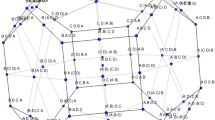Abstract
An axiomatic approach is applied to the problem of extracting a ranking of the alternatives from a pairwise comparison ratio matrix. The ordering induced by row geometric mean method is proved to be uniquely determined by three independent axioms, anonymity (independence of the labelling of alternatives), responsiveness (a kind of monotonicity property) and aggregation invariance, which requires the preservation of group consensus, that is, the pairwise ranking between two alternatives should remain unchanged if unanimous individual preferences are combined by geometric mean.


Similar content being viewed by others
References
Aczél J, Saaty TL (1983) Procedures for synthesizing ratio judgements. J Math Psychol 27(1):93–102
Arrow KJ (1950) A difficulty in the concept of social welfare. J Polit Econ 58(4):328–346
Barzilai J (1997) Deriving weights from pairwise comparison matrices. J Oper Res Soc 48(12):1226–1232
Barzilai J, Cook WD, Golany B (1987) Consistent weights for judgements matrices of the relative importance of alternatives. Opera Res Lett 6(3):131–134
Bozóki S, Fülöp J, Rónyai L (2010) On optimal completion of incomplete pairwise comparison matrices. Math Comput Model 52(1–2):318–333
Bozóki S, Tsyganok V (2017) The logarithmic least squares optimality of the geometric mean of weight vectors calculated from all spanning trees for (in)complete pairwise comparison matrices. Manuscript. arXiv:1701.04265
Brunelli M (2017) Studying a set of properties of inconsistency indices for pairwise comparisons. Ann Oper Res 248(1):143–161
Brunelli M, Fedrizzi M (2015) Axiomatic properties of inconsistency indices for pairwise comparisons. J Oper Res Soc 66(1):1–15
Bryson N (1995) A goal programming method for generating priority vectors. J Oper Res Soc 46(5):641–648
Chebotarev P, Shamis E (1998) Characterizations of scoring methods for preference aggregation. Ann Oper Res 80:299–332
Choo EU, Wedley WC (2004) A common framework for deriving preference values from pairwise comparison matrices. Comput Oper Res 31(6):893–908
Cook WD, Kress M (1988) Deriving weights from pairwise comparison ratio matrices: an axiomatic approach. Eur J Oper Res 37(3):355–362
Crawford G, Williams C (1980) Analysis of subjective judgment matrices. In: Interim report R-2572-AF. Rand Corporation, Santa Monica
Crawford G, Williams C (1985) A note on the analysis of subjective judgment matrices. J Math Psychol 29(4):387–405
Csató L (2015) A graph interpretation of the least squares ranking method. Soc Choice Welf 44(1):51–69
Csató L (2017) Eigenvector method and rank reversal in group decision making revisited. Fundam Inform 156(2):169–178
Csató L (2018a) Axiomatizations of inconsistency indices for triads. Manuscript. arXiv:1801.03355
Csató L (2018b) Characterization of an inconsistency ranking for pairwise comparison matrices. Ann Oper Res 261(1–2):155–165
Csató L (2018c) A characterization of the logarithmic least squares method. Manuscript. arXiv:1704.05321
Csató L (2018d) An impossibility theorem for paired comparisons. Cent Eur J Oper Res. forthcoming. https://doi.org/10.1007/s10100-018-0572-5
Csató L (2018e) Some impossibilities of ranking in generalized tournaments. Manuscript. arXiv:1701.06539
Csató L, Rónyai L (2016) Incomplete pairwise comparison matrices and weighting methods. Fundam Inform 144(3–4):309–320
De Graan JG (1980) Extensions of the multiple criteria analysis method of T. L. Saaty. In: Report. National Institute for Water Supply, Voorburg
Dijkstra TK (2013) On the extraction of weights from pairwise comparison matrices. Cent Eur J Oper Res 21(1):103–123
Fichtner J (1984) Some thoughts about the mathematics of the Analytic Hierarchy Process. Technical report, Institut für Angewandte Systemforschung und Operations Research, Universität der Bundeswehr München
Fichtner J (1986) On deriving priority vectors from matrices of pairwise comparisons. Socio-econ Plan Sci 20(6):341–345
Genest C, Lapointe F, Drury SW (1993) On a proposal of Jensen for the analysis of ordinal pairwise preferences using Saaty’s eigenvector scaling method. J Math Psychol 37(4):575–610
González-Díaz J, Hendrickx R, Lohmann E (2014) Paired comparisons analysis: an axiomatic approach to ranking methods. Soc Choice Welf 42(1):139–169
Janicki R, Soudkhah MH (2014) On classification with pairwise comparisons, support vector machines and feature domain overlapping. Comput J 58(3):416–431
Johnson CR, Beine WB, Wang TJ (1979) Right-left asymmetry in an eigenvector ranking procedure. J Math Psychol 19(1):61–64
Kendall MG (1955) Further contributions to the theory of paired comparisons. Biometrics 11(1):43–62
Lundy M, Siraj S, Greco S (2017) The mathematical equivalence of the spanning tree and row geometric mean preference vectors and its implications for preference analysis. Eur J Oper Res 257(1):197–208
Nitzan S, Rubinstein A (1981) A further characterization of Borda ranking method. Public Choice 36(1):153–158
Pérez J, Mokotoff E (2016) Eigenvector priority function causes strong rank reversal in group decision making. Fundam Inform 144(3–4):255–261
Rabinowitz G (1976) Some comments on measuring world influence. Confl Manage Peace Sci 2(1):49–55
Saaty TL (1980) The analytic hierarchy process: planning, priority setting, resource allocation. McGraw-Hill, New York
Saaty TL, Hu G (1998) Ranking by eigenvector versus other methods in the analytic hierarchy process. Appl Math Lett 11(4):121–125
Saaty TL, Vargas LG (1984) Inconsistency and rank preservation. J Math Psychol 28(2):205–214
van den Brink R, Gilles RP (2009) The outflow ranking method for weighted directed graphs. Eur J Oper Res 193(2):484–491
Young HP (1974) An axiomatization of Borda’s rule. J Econ Theory 9(1):43–52
Acknowledgements
We are grateful to Sándor Bozóki and Matteo Brunelli for useful advice. We thank two anonymous referees for beneficial remarks and suggestions. The research was supported by OTKA Grant K111797 and by the MTA Premium Post Doctorate Research Program.
Author information
Authors and Affiliations
Corresponding author
Rights and permissions
About this article
Cite this article
Csató, L. Characterization of the Row Geometric Mean Ranking with a Group Consensus Axiom. Group Decis Negot 27, 1011–1027 (2018). https://doi.org/10.1007/s10726-018-9589-3
Published:
Issue Date:
DOI: https://doi.org/10.1007/s10726-018-9589-3




